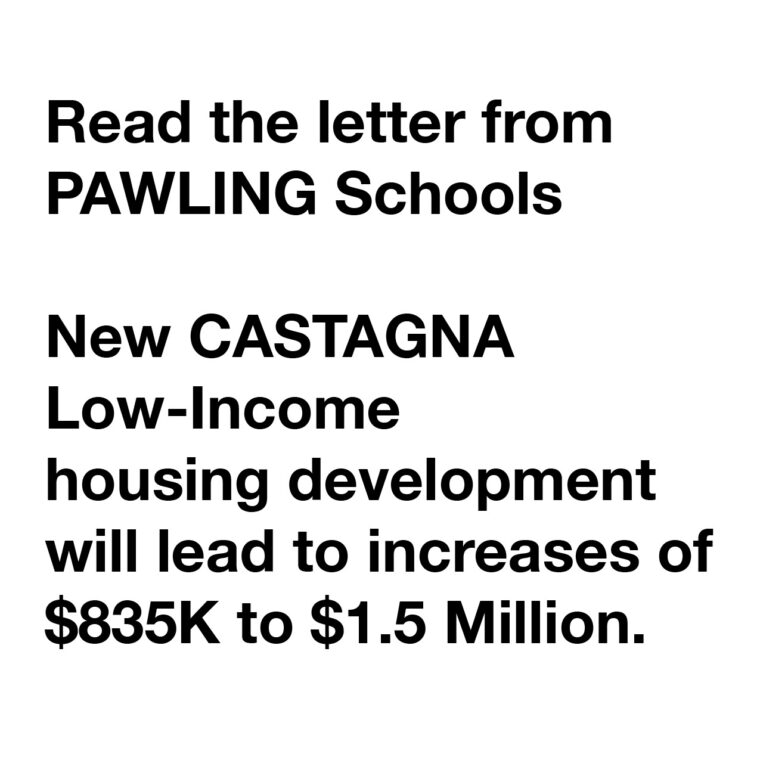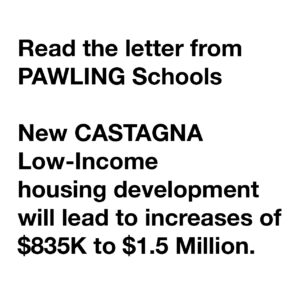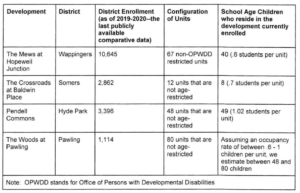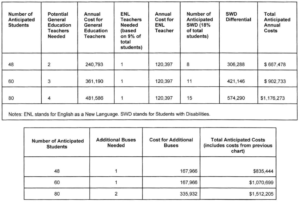letter from Kim Fontana, Superintendent of Schools – Pawling Central School District
Pawling Central School District Administrative Offices, 515 Route 22, Pawling, NY 12564 845-855-4600 – 845-855-46 I 2 (fax)
www.pawlingschools.org
November 23, 2021
George Brehm, Chairman
Town of Pawling Planning Board
160 Charles Colman Boulevard Pawling, NY 12564
Dear Mr. Brehm:
Thank you for your recent letter and allowing the Pawling Central School District the opportunity to comment upon potential impacts associated with the proposed Woods at Pawling Development. In addition to receiving your letter, I have had the opportunity to meet with the developer, and to review the recent Planning Board meeting minutes as well as much of the history of the Castagna Planned Development District, last acted upon by the Town Board in August of 2016. The response below has three sections: 1. general information about school finances as they relate to enrollment and funding, 2. specific impacts that we anticipate may result to the District should the Woods at Pawling project go forward, and 3. ways we can foresee that such impacts could be mitigated in a collaborative effort to welcome new families without doing significant harm to our current school programs or dramatically raising our tax levy and thus the community’s tax burden.
l. Enrollment and School Funding:
The developer’s analysis accurately noted that most school districts in New York State have experienced declining enrollment over the past two decades. Pawling CSD too has experienced a gradual decline in enrollment over the last twenty years; however, in the past four years, the changes in enrollment for Pawling have been as follows: plus 1% in 2021, minus 2% in 2020, minus 1% in 2019, and minus .44% in 2018. We have 19 fewer students in 2021 than in 2018. The developer’s analysis further suggests that declining enrollment is a problem for school districts. It is crucial for the public to understand that in fact declining enrollment is the primary way that school districts in New York State have been able to deliver tax levies under the 2% cap and thus is in fact a benefit to school programs and the taxpayer. With
approximately 70% of annual school district budgets consisting of labor costs, and with wage agreements generally rising in the neighborhood of 3% annually in an increasingly competitive market, one way school districts have managed to control costs is by not replacing staff as enrollment has declined. This is a strategy we have used in Pawling very consistently over the past decade. While we have not had layoffs, we have been able to retire positions with individuals or reappropriate those positions to other newly mandated or program-enhancing purposes, to, for example, meet the growing needs of a multilingual population and provide other needed services.
A recent example will illustrate this point. Pawling was able to add a Pre-Kindergarten Classroom this year because declining enrollment provided the classroom space and because a combination of declining enrollment and our relatively low (compared to the State) classification rate allowed us to reassign teacher aides to this classroom. The State funding we received came close to off-setting the salary and benefits for the teacher, but without the factor of declining enrollment, we would not have been able to offer this program without an increased burden to the taxpayer. There are multiple other examples in Pawling and in fact most school districts have had similar experiences. To be clear, it is in fact because of declining enrollment that Pawling and similar schools throughout New York State have been able to maintain, and in many cases improve, programs and services without adversely affecting either the taxpayer or our programs. Those districts that have had to precipitously cut programs have almost all been affected by increases in enrollment. Based on live births in families of existing residents, our kindergarten enrollment numbers are expected to hold essentially steady over the next five years, while overall the District should continue to have a very slight decline in enrollment as larger classes graduate, enabling us to maintain programs and stay within the tax levy cap.
Another somewhat common misconception relates to the relationship between State aid and economic disadvantage in which there is an assumption that increasing the percentage of economically disadvantaged students brings considerably more State aid to the school district. This misconception becomes relevant insofar as affordable housing may attract families without economic advantage. The actual percentage of students who are defined as economically disadvantaged in Pawling has roughly tripled in the past ten years, with 11% of students falling into this category in 2012 and 34% in this category today. Our Title I funding, however, has not kept pace with this increase. We were awarded $58,000 in 2012 and $134,000 this year. With these funds, we partially defray the salary and benefits of one elementary reading teacher and pay for certain mandated set-asides for homelessness and community involvement. So, while we welcome all students, it is not accurate to suggest that an increased percentage of students who are without economic advantage will bring even a proportionate increase in funding.
2. Likely Numbers of School-age Children to be Welcomed into the Pawling Schools:
The developer’s analysis suggests that there will be between 21 and 42 students enrolled based on two studies. This analysis identifies multiplier factors between an average of .29 children per unit to .55 children per unit. In order to estimate the number of students to be enrolled, we collected empirical data from the developments built by the same developer in somewhat comparable locations: The Crossroads at Baldwin Place, the Mews at Hopewell Junction, and Pendell Commons in Poughkeepsie. While these three developments are in much larger districts, these local Hudson Valley developments make a highly pertinent comparison group.
Given that the three other districts have more available rental options, due to their size and diversity, we would anticipate a higher rate of occupancy by families with school-aged children than the other districts. In addition, the impact of every single additional student is far greater in a small district than in a larger one where there are more classes and schools over which to distribute the additional students without hiring additional staff or opening additional classrooms. Thus, our analysis discloses a multiplier factor of between .6 and I child per unit. We might also posit that the multiplier factor should perhaps be even higher given the demand resulting from COVID migration out of New York City into the Hudson Valley, which has happened since these comparable developments were initially occupied. The actual students living in these developments are also somewhat heavily weighted toward elementary grades even though they have been occupied for several years. It is more difficult to absorb elementary students than secondary students without adding teaching staff, and elementary parents are more sensitive to larger class sizes than parents of secondary students.
In terms of financial impacts of additional students, please see the tables below:
The foregoing makes the following assumptions:
- Incoming students will reflect State-wide averages in terms of special education classification and English language learner status.
- Full size school buses in Pawling carry up to 66 elementary students and up to 44 secondary students in a typical situation (without COVID restrictions).
- The class sizes assumed are typical of Pawling’ s current class sizes and also consistent with our collectively bargained agreements.
- The per teacher cost is consistent with our recent hires based on years of experience and education.
- The total collection of students at 48 would be likely to necessitate two additional teachers not because the students would be likely to be concentrated in just two grades or subjects, but because we are close to our contractually permissible limits in at least two grades or subjects and thus significant increases would be likely to trigger at least this number of additional general education classroom teachers needed.
These types of increases could only be managed by attempting to override the tax levy cap, increasing class sizes, eliminating programs, or most likely, a combination of all three. To illustrate this point, please note that our current levy is $29,934,500. Additional annual costs of $667,478 reflect a levy increase of around 2.2%. Additional annual costs of$902,733 reflect a levy increase of around 3%. Additional annual costs of $1,176,273 reflect a levy increase of around 3.9%. Any of these levy increases would require 60% of voters to approve or place us in a contingency budget, which would subject the district to multiple budget restrictions, ultimately resulting in the loss of student programs.
3. Possible Mitigation Strategies to Enable Pawling to Welcome the Students without Negatively Impacting the Tax Levy or Student Programs:
- One of the anticipated costs above is for one or two school buses. This is one-time purchase and funding from the developer via a Host Benefit Agreement to equal the cost of the bus(es) would help limit one single large increase.
- The potential number of children can be limited by changing the configuration of the apartments to more age-restricted and more one-bedroom apartments.
- Staging the opening of the apartments to rental over multiple years would help the District avoid steep increases in expenditure in a given year.
- Ongoing financial support via a negotiated PILOT agreement, should it become applicable, could assist the District in defraying expenses associated with projected enrollment increases, preserving a steadier budget and existing school programs.
- Similarly, a negotiated Host Benefit agreement would assist the District in defraying these same expenses and help to protect the existing school programs without putting undue burden on the taxpayers.
Collaboration Needed to Move Forward
To conclude, we welcome all students and families to Pawling. Like all employers, we are eager to enhance our workforce. In addition, we welcome newcomers and diverse families into our community. Diversity is an asset to our schools and our community. We are also proud of our schools and we see our schools as an important avenue for children and families to gain opportunities. Nonetheless, it is imperative for the Planning Board and the community to understand the magnitude of such a project on our very small school district. The percentages of increases to budget and tax levy are far higher than in any district in which Kearney Development Corporation has developed property and it is critical for the Planning Board to take the full measure of this impact into consideration.
I will be pleased to participate in any conversations that will aid your decision or inform your deliberation as I am confident we share concern for, and commitment to, our schools and community.
Signed Very truly yours by Kim Fontana
(Kim is Superintendent of Schools – Pawling Central School District)
cc: Pawling CSD Board of Education Christopher Langlois, Esq., District Counsel Town of Pawling Planning Board
James Schmitt, Supervisor, Town of Pawling Town of Pawling Trustees
Ken Kearney
PCSD Website
note: to see the original letter with signature follow this link: https://drive.google.com/drive/folders/1DWWaI_G4Pw_02WgxH5QqJZrDbi9OyjST




